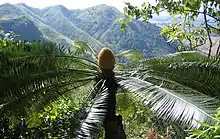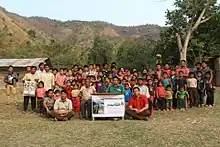Cycas pectinata
Cycas pectinata was the fourth species of Cycas to be named; it was described in 1826 by Scottish surgeon and botanist Francis Buchanan-Hamilton from Kamrup, Assam in northeast India. The species is one of the most widespread cycads. It is found in the northeastern part of India (Assam, Manipur, Meghalaya, Sikkim, Darjeeling), Nepal, Bhutan, northern Burma, southern China (Yunnan), Bangladesh, Burma, Malaysia, Cambodia, northern Thailand, Laos, and Vietnam.[3][4][5][6] Cycas pectinata usually grow at elevation 300 m to 1200 m and in difficult terrains.[7][8][9] In China, it grows in dry, open thickets in limestone mountains, red soil in sparse monsoon forests.[10] Cycas pectinata grows up to 40 feet (12 m) tall and has very large, ovoid male cones. The tallest Cycas pectinata is a female plant in North Kamrup, Assam which measures 52.8 feet (16.1 m). The tree is the world's tallest Cycas plant.[11] In Northeast India, the species is under severe threat due to clearing of forest and overcollection of male cones for preparation of traditional medicines.[12][13] The species is listed in CITES Appendix II and IUCN Redlist.
| Cycas pectinata | |
|---|---|
 | |
| Natural habitat in Manipur, India | |
| Scientific classification | |
| Kingdom: | Plantae |
| Clade: | Tracheophytes |
| Clade: | Gymnosperms |
| Division: | Cycadophyta |
| Class: | Cycadopsida |
| Order: | Cycadales |
| Family: | Cycadaceae |
| Genus: | Cycas |
| Species: | C. pectinata |
| Binomial name | |
| Cycas pectinata | |
| Synonyms[2] | |
|
Cycas dilatata Griff. | |
Historical information
Cycas pectinata was described by Hamilton in 1826 from “On the hills which bound Bengal to the east” with its habitat at “Camrupae sylvis”.[14] Kamrup (Camrupae) is a district in Assam (Northeast India).
Morphology
Tall evergreen trees with crown of leaves at the apex of trunk. Stems robust, glabrous at base and usually branched when mature. Leaves 1 to 2 m long, dark green. Male cones usually large, cylindrically ovoid and yellowish or orange in maturity. Megasporophylls deeply pectinate and densely covered with hairs. Seeds ovoid, glabrous and orange to red-yellow on maturity.
Uses
Economic
Cycas pectinata is popular ornamental plant grown in gardens and at public places. In Assam, green mature leaves are used to decorate large numbers of temporary shrines called “Pooja Pandals,” erected to worship deities during festivals. The leaves are used for decoration of the entrance of the marriage pandals and bouquets.
Traditional
Young fronds are eaten as vegetables in Manipur and Sikkim. Seeds of Cycas pectinata are traditionally utilized as a source of starch by indigenous tribes and are eaten raw or roasted in Assam and the bordering region of Meghalaya. Microsporophylls are chewed raw to cure stomach-aches and ulcers. The young microsporophylls are eaten by young men in Meghalaya and Assam to enhance male sexual potency
Conservation efforts

In Northeast India, two conservation program are going on for the conservation of Cycas pectinata populations in the state of Assam and Manipur.[15] In 2014, Yendang: The Living Fossil, a cycad conservation program involving indigenous tribes and state forest department started in one of the cycad localities of Manipur (Yendang is local name of Cycas pectinata in Manipur). From 2015 onwards, Cycadologists and cycad lovers are organising Cycad Volleyball Tournament in Manipur to create awareness among the locals and to encourage youths in safeguarding the cycad populations.
References
- Nguyen, H.T. (2010). "Cycas pectinata". IUCN Red List of Threatened Species. 2010: e.T42062A10617695. doi:10.2305/IUCN.UK.2010-3.RLTS.T42062A10617695.en. Retrieved 19 November 2021.
- "Cycas pectinata". Germplasm Resources Information Network. Agricultural Research Service, United States Department of Agriculture. Retrieved 29 October 2010.
- Hill, K.D. 1998-2012. http://plantnet.rbgsyd.nsw.gov.au/cgi-bin/cycadpg?taxname=Cycas%20pectinata
- Rita Singh & Khuraijam Jibankumar Singh, 2010. "Archived copy" (PDF). Archived from the original (PDF) on 2014-07-14. Retrieved 2014-06-30.
{{cite web}}: CS1 maint: archived copy as title (link) - Pant, D.D., Singh, R. & Chauhan, D.K. 1994. On Cycas pectinata Hamilton from North-East India. Encephalartos, 38: 17-30
- Osborne, R.; Hill, K.D.; Nguyen, H.T. & Phan Ke, L. 2007. Cycads of Vietnam. Osborne, Brisbane (Australia) and Eeden, Capre Town (South Africa)
- Whitelock, L.M. 2002. The Cycads. Timber Press, Portland.
- Jones, D. L. 2002. Cycads of the world. Smithsonian Institution Press, Washington, DC
- Lindstrom, A.J. & Hill, K.D. 2007. The genus Cycas (Cycadaceae) in India. Telopea 11(4):463 – 488
- Fu Shu-hsia, Cheng Wan-chün, Fu Li-kuo & Chen Chia-jui. 1978. Cycadaceae. In: Cheng Wan-chün & Fu Li-kuo, eds., Fl. Reipubl. Popularis Sin. 7: 4-17 http://www.efloras.org/florataxon.aspx?flora_id=3&taxon_id=200005229
- Khuraijam Jibankumar Singh & Rita Singh, 2012. http://www.indianforester.co.in/index.php/indianforester/article/view/29048
- Khuraijam Jibankumar Singh & Rita Singh, 2014. Population assessment and distribution of Cycas pectinata Buchanan-Hamilton in Northeast India, Pleione 8(1): 17 - 25.
- Khuraijam Jibankumar Singh & Rita Singh. 2012. The ethnobotany of Cycas in the states of Assam and Meghalaya, India. Proceedings of 8th International Conference on Cycad Biology, Panama. Memoirs of The New York Botanical Garden. The New York Botanical Garden: New York. http://www.cycadsofindia.in/p/recent-publications.html
- Hamilton. 1826. Mem. Wern. Nat. Hist. Soc. 5(2): 322-323, figs 3, 5
- Khuraijam Jibankumar Singh & Rita Singh. 2012. Cycad conservation and its challenges in India. In Bhattacharya and Garg (eds) News challenges: New opportunities in environment. McMillan: New Delhi
